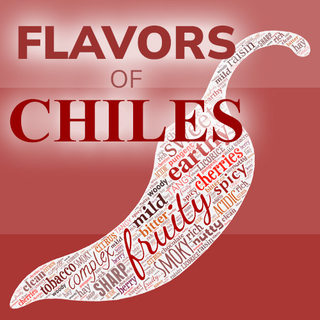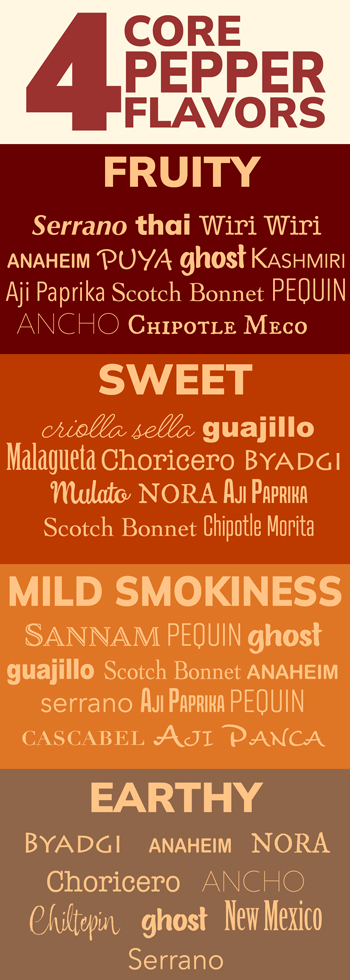The Flavors of Chiles

What Are Pepper Flavors?
Chile peppers are complex fruits and, like wine, can express a wide range of flavors in just one fruit. They can be smoky and sweet or earthy and raisin-like.
As chiles grow and ripen, their flavors reflect their growing stage; when they are young, they tend to be green and tart or grassy, though the flavors tend to have one main note. When chiles ripen, the fruits’ sugars develop, and they become sweeter and more complex.
When a chile is picked, the flavor development stops at the point of harvest; if it is dried, that flavor concentrates as the water in the cell walls evaporates.
Do Peppers Have Any Flavor, Or Are They Just Hot?
Chile peppers can be packed with flavor! We have a misperception that chiles—especially if they are red—are just here to add heat. That couldn’t be more wrong; chile peppers run the gamut of heat from mild to crazy hot, often delivering a wealth of flavors along with the heat.
Mild chiles, like Ancho or Choricero, are usually bred to taste terrific and deliver rich flavors like chocolate, raisin, or cherry. Medium heat peppers like Chipotle Morita bring more heat but are also sweet and smoky.
Some hot peppers, like the Tien Tsin, are bred mainly for their heat and are only vaguely flavorful. Other hot peppers, like the Habanero, bring beautiful, tropical notes of papaya and coconut to the table. The trick with these peppers is figuring out how to enjoy the flavor of the peppers around the scorching heat.
Table of Contents
Understanding Flavor And Taste
Does Terroir Affect the Flavor of Chiles
Understanding Flavor And Taste
Flavor and taste are often used interchangeably, but these words mean different things.
Taste refers to the sensory input from receptors on the tongue—the basic tastes of salty, sweet, sour, bitter, savory, or umami. The taste sensation occurs when food molecules attach to taste buds, which determine the basic makeup of that food. These interactions occur on the tongue and the mouth's soft palate.
Flavor describes the synergy that occurs primarily, but not only between taste and aroma.
When we eat food, particles that create aroma and flavor turn to vapor and are detected by receptors that line the back of our throats and go up to the nose. These start to make the thousands of nuanced flavors we can see when we eat; the entire process of flavor detection also includes how we experience texture, food’s physical temperature, and perceptions of hot or cold brought on by triggering agents like menthol or capsaicin1.
Does Terroir Affect the Flavor of Chiles

The French term terroir is usually applied to grapes and wine; it is the word that embodies the concept that terrain, soil, climate, and tradition can profoundly influence the way produce tastes.
Chile pepper researchers like Professor Paul Bosland of New Mexico’s Chile Pepper Institute give a definitive yes to this question; he even recommends that people ask for chile varietals like one would ask for a glass of wine2.
People often use the term “landrace” to describe chiles that have been specialized to an area. To put these terms in context, landrace chiles are what a specific terroir can help create.
For example, Anaheim peppers are cousins to the Hatch chile. Seeds from Hatch, New Mexico were taken to California in 1894 for commercial farming. Anaheim peppers became a mild and grassy cultivar, with an unobtrusive flavor that lends itself to a wide range of applications. In Hatch, New Mexico, the mineral-rich soil, hot days, cool nights, and traditional farming methods worked a particular magic on these peppers and created a pepper with a more robust flavor than its California cousins.
The Original 6 Chile Pepper Classifications
The chile pepper originated in South America 10,000 years ago and made its way through trade and natural fertilization to central Mexico, where it was domesticated. By the 1500s AD, peppers were thoroughly interwoven into the culinary life of the Aztec civilization.
Bernardino de Sahagún, a Franciscan monk and ethnographer, was sent to Mexico in 1529 to document the ways of the Aztecs. At the end of more than 50 years of careful observation, he had amassed writings that were compiled into The Florentine Codex, a 12-volume exploration of the many aspects of Aztec culture.
His work was precise and detailed. Among his topics, he discussed the chile vendors at the local markets, the vast array of chiles, and their particular attention to chile flavors and heat.
In 1569, de Sahagún observed “hot green chiles, smoked chiles, water chiles, tree chiles, flea chiles, and sharp-pointed red peppers,” talking at length about the flavors, colors, and aromas of the chiles.
Aztec vendors were particular about their chiles, de Sahagún said, breaking them into six categories, determined by factors like pungency (high to low) and type of pungency (sharp to broad). They also had cooking tips and directed people to pair “frog with green chile, newt with yellow chile, tadpoles with small chiles.3”
They paid such notice and care to chile peppers because they knew that chiles add heat and flavor and can enhance a compatible food in wonderful ways.
Pepper Flavor Profiles
Like the Aztecs, we recognize that chile peppers have unique pepper flavor profiles. They are special, versatile ingredients and can add tremendous flavor to food and spicy heat. We’ve compiled a list of over 30 flavor characteristics associated with chiles and the peppers that deliver these flavors.
Please bear in mind: A pepper can have more than one associated characteristic, so that you may see some listed more than once.
Fruity
This is one of our most popular descriptors! Chile peppers are berries, and ripening gives their fruity family history a chance to shine. Here are the chiles that we think are fruity:
Aji Amarillo, Aji Panca, Anaheim, Ancho, Chipotle Meco, Costeno Rojo, Ghost, Kashmiri, Pequin, Puya, Scorpion, Scotch Bonnet, Serrano, Thai, Wiri Wiri.
Sweet
This is another popular flavor description that points to the berry-like nature of the chile. Here’s a list of sweet flavored chiles:
Aji Paprika, Anaheim, Byadgi, Chipotle Morita, Choricero, Criolla Sella, Ghost, Guajillo, Kashmiri, Malagueta, Mulato, New Mexico, Nora, Scotch Bonnet.
Smoky
Sometimes chiles develop a smoky flavor during the drying process, and sometimes the smoke is introduced into the drying process to impart a bit of flavor. Either way, smoky chiles are delicious. Here are the chiles we have that offer a light touch of natural smoky goodness:
Aji Panca, Aji Paprika, Anaheim, Calabrian, Cascabel, Ghost, Guajillo, Guntur Sannam, Pequin, Scotch Bonnet, Serrano.
Earthy
Earthy chiles have a robust nuance that gives peppers a deep backbone and will do the same for your recipes. Here is our list of rich, earthy chiles:
Anaheim, Ancho, Byadgi, Chiltepin, Choricero, Ghost, New Mexico, Nora, Serrano.
Other Common Chile Flavor Characteristics
There are many more flavors to experience in chile peppers than those listed above. Here are the other flavors we’ve identified and the chiles that express these flavors:
| Spicy | Chipotle Meco, Thai Bird Chile |
| Clean | African Bird’s Eye, Japones |
| Sharp | Aji Amarillo, African Bird’s Eye, Chiltepin, Japones, Malagueta, Pasilla de Oaxaca |
| Pungent | Anaheim, Habanero, Pasilla Negro, Tien Tsin |
| Acidic | Cascabel, de Arbol, New Mexico, Serrano |
| Grassy | Chipotle Meco, Costeno Rojo, de Arbol |
| Tangy | Anaheim, Pasilla Negro |
| Bitter | Ancho, Chipotle Morita, Choricero, Ghost |
| Nutty | Cascabel, Costeno Rojo, de Arbol, Pequin |
| Hay | African Bird’s Eye |
| Woody | Calabrian, Cascabel, Pasilla Negro |
| Citrus | Criolla Sella, Pequin |
| Richness | Nora, Pasilla Negro |
| Mango | Criolla Sella |
| Full Body | Aji Amarillo |
| Complex | Aji Panca, Costeno Rojo, Criolla Sella, Guntur Sannam |
| Astringent | Guajillo |
| Cherry-like | Choricero, Mulato, New Mexico, Puya, Guntur Sannam, Scotch Bonnet |
| Raisin-like | Aji Paprika, Ancho, Calabrian, Choricero, Pasilla Negro |
| Tobacco | Aji Paprika, Ancho, Cascabel, Pasilla de Oaxaca, Guntur Sannam |
| Plummy | Ancho, Calabrian |
| Chocolate | Ancho, Chipotle Morita, Mulato, Pasilla Negro |
| Soapy | Costeno Rojo |
| Pine | Guajillo |
| Papaya | Habanero |
| Coconut | Habanero |
| Coffee | Mulato |
| Licorice | Criolla Sella, Mulato, Puya |
| Weedy | New Mexico |
| Apple | Scotch Bonnet |
| Tomato | Scotch Bonnet |
| Berries | Guajillo, Habanero, Malagueta |
Dried Pepper Flavor Chart
Now that we’ve looked at the different flavors that a pepper can express, we thought we’d make it easy for you to pinpoint the sort of pepper you might need. We’ve compiled the flavors for each pepper, along with their Scoville Heat Unit measurement.

African Bird’s Eye – Clean, sharp, and hay-like. 100,000-225,000 SHU.
Aji Amarillo – Fruity, sharp, and full-bodied. 30,000-50,000 SHU.
Aji Panca – Fruity, mildly smoky, and complex. 500-1,500 SHU.
Aji Paprika – Sweet, mildly smoky, raisin-y, and tobacco-y. 100-500 SHU.
Anaheim – Fruity, sweet, mildly smoky, earthy, mild pungency, tangy. 500-1,000 SHU.
Ancho – Fruity, earthy, bitter, raisin-y, tobacco-y, plummy, chocolate. 1,000-1,500 SHU.
Byadgi – Sweet, earthy. 15,000-25,000 SHU.
Calabrian – Mildly smoky, woody, raisiny, plummy. 5,000-25,000 SHU.
Cascabel – Mildly smoky, acidic, nutty, woody, tobacco-y. 1,000-2,500 SHU.
Chiltepin – Smoky, earthy, sharp. 100,000-250,000 SHU.
Chipotle Meco – Spicy, fruity, smoky, grassy. 2,500-10,000 SHU.
Chipotle Morita – Sweet, smoky, bitter, chocolate. 2,500-10,000 SHU.

Choricero – Sweet, earthy, bitter, cherry-like, raisin-y. 175-300 SHU.
Costeno Rojo – Fruity, grassy, nutty, complex, soapy. 5,000-15,000 SHU.
Criolla Sella – Sweet, citrusy, rich, mango-y, complex, licorice. 20,000-30,000 SHU.
De Arbol – Acidic, grassy, nutty. 15,000-30,000 SHU.
Ghost – Fruity, sweet, mildly smoky, earthy, bitter. 1,000,000+ SHU.
Guajillo – Sweet, mildly smoky, astringent, piney, tart berries. 2,500-5,000 SHU.
Guntur Sannam – Mildly smoky, complex, cherry-like, tobacco-y. 25,000-35,000 SHU.
Habanero – Pungent, papaya, coconut, berry. 100,000-350,000 SHU.
Japones – Clean, sharp. 15,000-30,000 SHU.
Malagueta – Sweet, sharp, berry. 120,000-160,000 SHU.
Mulato – Sweet, smoky, cherry-like, chocolate, coffee, licorice. 1,000-1,500 SHU.

New Mexico – Sweet, earthy, acidic, cherry-like, weedy. 800-1,400 SHU.
Nora – Sweet, earthy, rich. 500 SHU.
Pasilla de Oaxaca – Smoky, sharp, tobacco-y. 15,000-20,000 SHU.
Pasilla Negro – Pungent, tangy, woody, rich, raisin-y, chocolate. 1,000-1,500 SHU.
Pequin – Fruity, mildly smoky, nutty, citrusy. 30,000-60,000 SHU.
Puya – Fruity, cherry-like, licorice. 5,000-10,000 SHU.
Scorpion – Spicy, fruity, clean. 500,000-1,400,000 SHU.
Scotch Bonnet – Fruity, sweet, mildly smoky, cherry-like, apple, tomato. 200,000-300,000 SHU.
Smoked Red Serrano – Fruity, mildly smoky, earthy, acidic. 8,000-18,000 SHU.
Thai Bird – Spicy, fruity, nutty. 70,000-130,000 SHU.
Tien Tsin – Spicy, mildly pungent. 10,000-60,000 SHU.
Wiri Wiri – Spicy, fruity. 60,000-80,000 SHU.
Best Tasting Peppers
The best-tasting peppers are the ones that are right for the job. Peppers come in a rainbow of flavors, so determining what “best” is depends entirely on the person eating a pepper and its dish.
Most milder peppers have been bred to emphasize their flavor, and you can see this when you look at the characteristics they express. Mild peppers like Anchos, Pasilla Negro, and Choricero are sweet, chocolatey, or rich.
The flavors in these peppers are evident because you don’t have to work to get around the heat, but that doesn’t mean that hot peppers don’t taste great, too. Habaneros taste like tropical fruits, with notes of papaya and coconut, and Scotch Bonnets have flavors that resemble tomato and apple.
 Where Does the Flavor of Chile Peppers Come From
Where Does the Flavor of Chile Peppers Come From
The flavor in chile peppers can be found entirely in the mesocarp, which is a fancy way of saying that it’s in the flesh of the pepper. The mesocarp is the part of the pepper between the outer, thick skin and the extremely thin membrane. It gives the chile pepper structure and holds most of the water in a pepper; depending on the peppers, 85-90% of their raw weight is made up of water4.
Do Pepper Seeds Add Flavor or Just Heat
Pepper seeds do not contribute significantly to the overall flavor of a chile pepper and can even be bitter and unpleasant.
The seeds are also not responsible for the heat in a pepper. That comes from the inner membrane and ribs, the white, pithy part of the pepper from which the seeds hang. Seeds may display higher amounts of capsaicin than the rest of the pepper because they often touch the ribs but don’t generate any heat on their own.
When Will Chiles Have the Best Flavor
This is another subjective question; a chile will have the best flavor when it’s at the stage that’s necessary to complete a dish successfully.
If you’re making a mole sauce, you want Anchos and Pasilla Negros that have been fully ripened and dried; you won’t try to make the sauce with fresh, green jalapeno. Likewise, you wouldn’t try to make chili pickles with dried peppers; for that, you’d use fresh jalapeno.
Most chiles will have a green stage where their flavor is more grassy and astringent, and if they are a spicy variety of pepper, that spice will be a bit more up-front.
As a chile ripens and the sugars in the pepper develop, they become more mellow, both in their heat and flavor. They are edible at any stage of their development, so it’s essential to understand which flavors you’re looking for to maximize the delicious resources found inside a chile pod.
Chile peppers have been a favorite ingredient in foods around the globe for millennia, but they’ve only emerged in force on the American food scene in the last fifty years or so. There’s a lot to learn about the flavors of peppers and how they can contribute to a meal. All you need is a willingness to learn and a spirit of adventure to successfully embrace the world of chile peppers.
References
1. Penttila, N. (2019, September 19). The senses: Smell and taste. Dana Foundation. Retrieved June 30, 2022.
2. Biggers, A. M. (2021, September 7). Does it matter where your chile is grown? New Mexico Magazine. Retrieved June 30, 2022.
3. Bosland, P. W. (1999). Chiles: A gift from a fiery god. HortScience, 34(5), 809–811.
4. USDA Staff. (n.d.). Fooddata Central Search Results. FoodData Central. Retrieved June 30, 2022.

